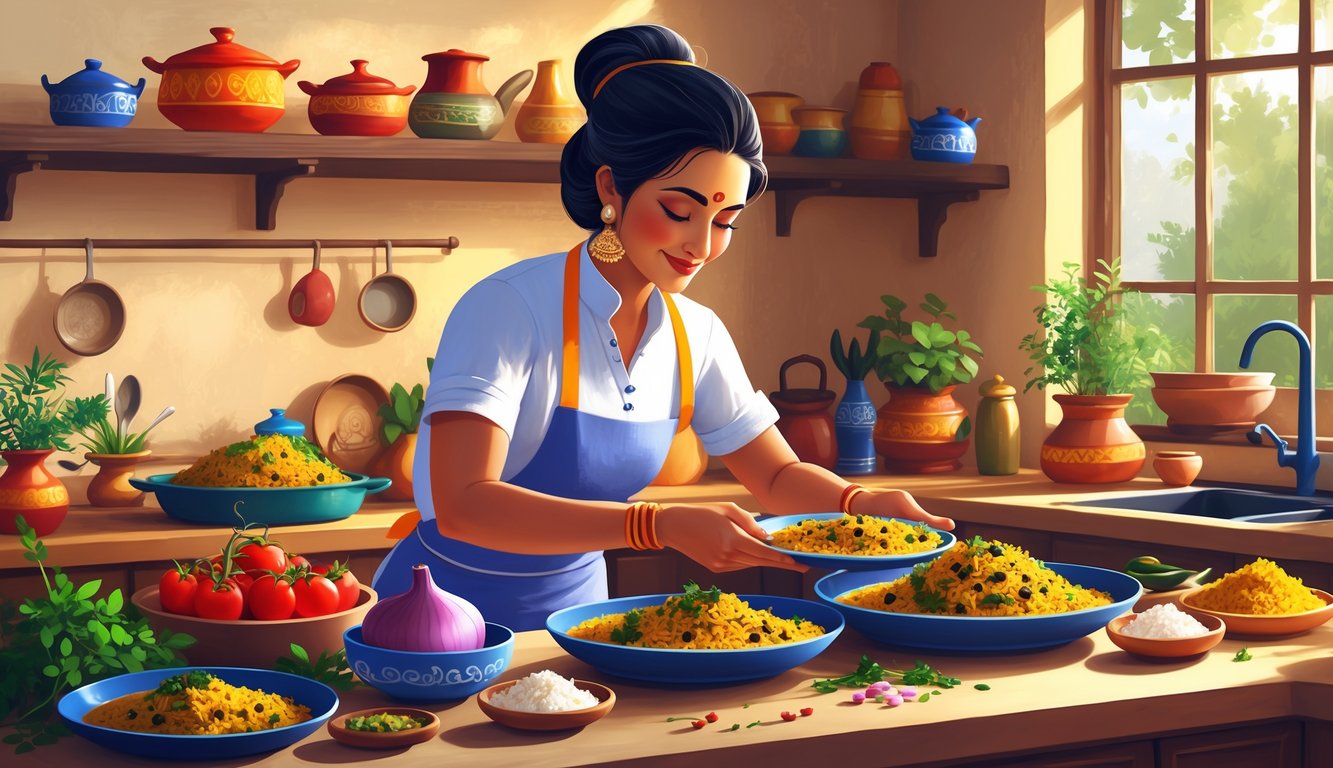
Sweets and Desserts: Finishing Touches
I keep staring at empty dessert boxes, wondering why I spent so much when I could just make it myself. Homemade sweets mean I get to pick the sugar level, the nuts, the milk—no weird chemicals, no tiny portions. Control freak? Maybe.
Homemade Kulfi
Why are the store kulfi boxes always freezer-burned and sad? Kulfi is basically ice cream’s denser, richer cousin—full of khoya, cream, and nostalgia. I use full-fat milk, boil it forever (like, 45 minutes, maybe more?), and keep stirring until my arm gives out. Skip that and you get disappointment on a stick. Marwari chefs on TV swear by saffron threads for the “real” flavor, which is kind of medicinal, but at least you know it’s not fake. Freeze it in little pots, and it’s gone before dinner. Secret move: add a splash of condensed milk for creaminess—authenticity be damned, my dentist didn’t complain, but my mom would.
Gulab Jamun and Classic Treats
People say you can’t beat restaurant gulab jamun at home—wrong, unless you’re the type who multitasks and burns the syrup. Overcooked syrup? Rock-hard balls? Been there. The trick is kneading the dough until it’s just right, using fresh paneer or milk powder (depending on which aunt you trust), and frying gently at 300°F.
I rushed once for a party—ended up with syrup rocks floating in sugar water. But if you get the rose water and the soaking time right, you’ll crush the store stuff every time. Ten to twenty minutes is the sweet spot—any longer and you’re in weird jelly territory. This quick guide says simple is best, and I agree.
Creative Pistachio Desserts
Pistachios just vanish in my kitchen—no trauma, I just can’t stop snacking. Sometimes I smash them into laddus, sometimes it’s pista barfi, and honestly, good ghee is everything. Learned this from a Gujarati sweets guy: roast your own pistachios, don’t trust the pre-shelled ones. The color is wild—almost too green.
You can make pista phirni, fudge, or halwa, and every time I do, I wonder why restaurant portions are so tiny. Nobody on those “authentic” dessert lists ever admits it, but a little salt makes pistachios pop. My nephew once said my pista kulfi was “too strong”—he eats plain bread, so, next. Leftovers? Never last.
Meal Planning: Breakfast, Dinner, and Brunch at Home
Telling people how to “outsmart” restaurant Indian food feels like cheating—especially when restaurants just microwave naan in the back and call it fresh. I’ve lost count of how many times I’ve tossed my meal plan and just winged it. That’s the whole point: meal planning is less about strict schedules, more about not panicking at 6 PM.
Quick Breakfast Options
Trying to make breakfast that isn’t just toast is a nightmare. Fresh dosa? Only if you remembered to soak rice last night. Otherwise, it’s upma or leftover sabzi parathas. Dietitians say eggs and oats cheela (which is just gram flour pancakes with hidden veggies) are healthy, but honestly, the real trick is prepping idli/dosa batter on Sunday. I just grab a container every night so I don’t have to think in the morning. Homemade besan chilla with mint chutney beats any restaurant breakfast when I’m half-awake. Or toast with peanut chutney podi—kids will eat that even if they refuse everything else.
Honestly, sometimes breakfast is just leftover dal upma or curd and bananas. Not glamorous, but at least I know what’s in it. Seeing my own breakfast rotation is weirdly satisfying, even if it’s not Instagram-worthy.
Hearty Dinners for Families
“Hearty”—what does that even mean? I only get it when three people complain about lauki again. Home dinners are this battle: avoid heavy cream gravies, but don’t disappoint the paneer fans. I make rajma early, let it cool, so the masalas actually settle in, not just a swirl of cream at the end.
Want to level up? Pressure cook your dals, then fry spices in ghee for the “tadka”—the smell alone is worth it. Even a basic bhindi masala with rotis beats greasy restaurant food. Table’s a mess, but I’ll take sticky dal over oily catering any day. Plus, leftovers are breakfast. Again.
Weekend Brunch Ideas
Saturday hits and suddenly, paying for restaurant brunch feels ridiculous. Why spend on bland chole bhature with sad salad when I’ve got chickpeas and yogurt at home? Supposedly, keeping dough or masala ready saves time—sometimes I do, sometimes not. I once made a masala omelette bar and mashed potatoes just because I was bored.
It’s chaos—everyone grabs dhokla and ghee theplas, then someone wants sandwiches. Fine, paneer tikka grilled with capsicum, why not. My only rule: keep a list of classics (poha, parathas, sweet lassi) and treat brunch like dinner’s unpredictable cousin. Supposedly, flexible brunches save weekend headaches. Me? I always end up making chai twice. So much for planning.
Tips from Experts to Elevate Your Indian Home Cooking
My grinder’s dying, the spices are stale, and I’m convinced restaurant kitchens have some secret hotline I’ll never get access to. Is there a trick? It’s not the fancy copper kadai, and nobody’s importing rare mangalorean chillies for weeknight dinner. It’s just patience, swapping ingredients on the fly, and occasionally getting it all wrong. Ghee in the wrong pan, turmeric envy—welcome to my kitchen.
Cooking Indian Food Like a Pro
First step, everything’s a mess. Too many pots, onions burning, and that voice in my head: “Cook the onions longer.” I’ve sat through hours of that angry chef on YouTube, and all I remember is something about deep browning. Bay leaves, sure, but don’t mess up the garam masala timing, or you’re doomed. My grandmother’s big on “taste before you salt,” but I’ve burned my tongue enough to know sometimes you just smell and hope for the best.
Ginger-garlic paste is weirdly precious. I make double, swap brands, and somehow, the fresher it is, the less my food screams “amateur hour.” High heat for tempering, low for simmering—everyone repeats this like a mantra. My friend bought those spice tins from the expert tips for homemade Indian food article—nice to look at, but technique wins, not equipment.
Balancing Spices With Precision
I lose count of cardamom pods every single time. TV chefs just throw in “a pinch” or “one stick” and wink, but I have no idea what that means. It’s not just about the number of spices; it’s the order and timing. Cumin before coriander. Or not. I watched some cooking show where someone got kicked off for toasting mustard seeds late—haunting, honestly.
I taped a spice chart to my cupboard, but yogurt still tasted like cloves once. Airtight jars? Game-changer. Aroma sticks around, curries taste almost restaurant-level. Warming whole spices first is supposed to pull out flavor, but if you wander off, you’ll be scraping burnt bits off the pan. Don’t multitask.
The 28 essential Indian cooking tips bounce between “don’t overthink it” and “measure everything.” But nobody says, “Just sniff it.” That’s sometimes all you need.
When to Use Fresh or Dried Herbs
Coriander plants? Dead on arrival here. Dried kasuri methi is my lifeline. The flavor’s different—dried is smoky, fresh is sharp and gone if you add it too soon. Chefs on TV grab curry leaves and I’m jealous. Tear them for more flavor, but who knows if they’re fresh or just sad?
Mint’s confusing. Fresh works in raita, dried in pulao is a disaster. Every Indian cooking secrets list says cilantro at the end. Parsley’s a joke. Ghee-fried herbs taste richer, but boil fresh ones and you get grass.
Kasuri methi on dal, coriander on biryani, dried curry leaves for sambar—sometimes I mix them up. If you’re bold with herbs, stop just before it feels too much, slap a lid on, and hope for the best.



